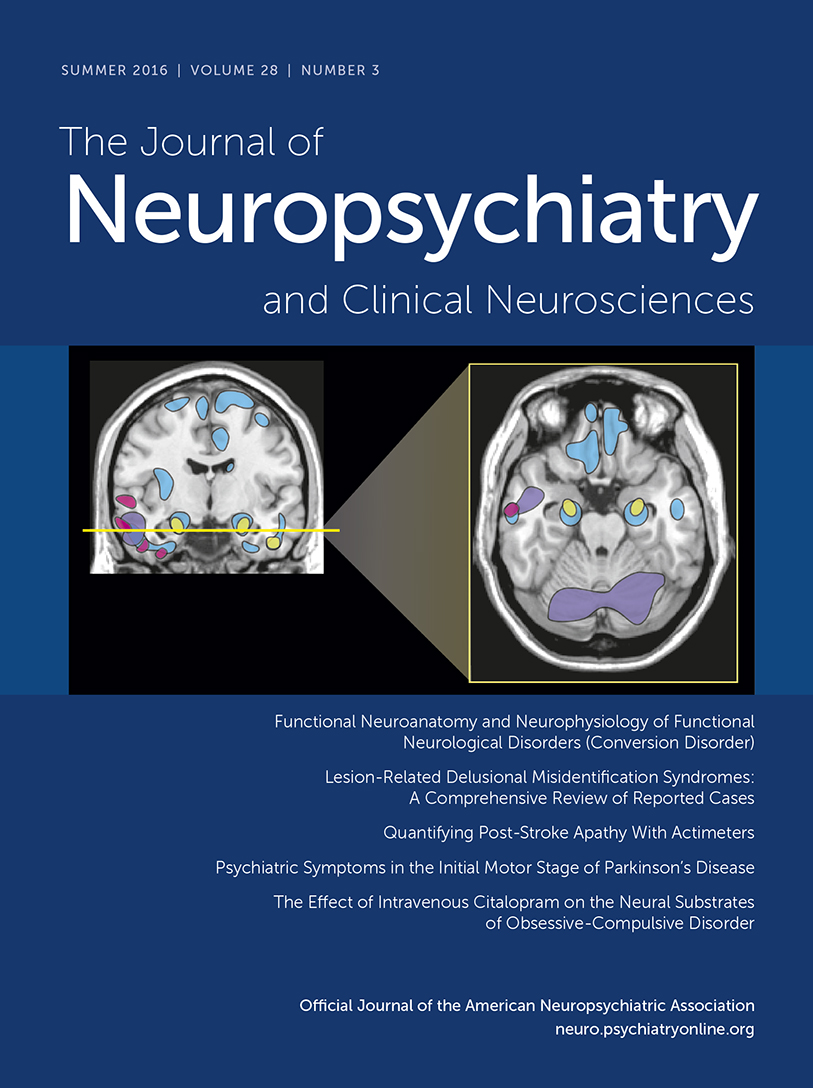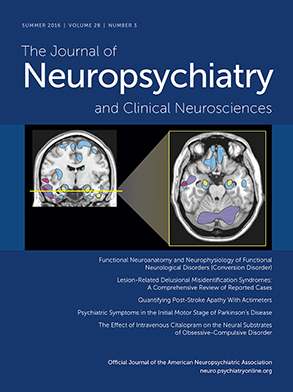Huntington’s disease (HD) is an inherited neurodegenerative disorder involving motor, cognitive, and emotional difficulties, for which the prevalence of affective symptoms ranges from 13% to 71% for anxiety
1 and from 15% to 69% for depression.
2,3 The high prevalence and variability of these estimates suggests that this is an important population to consider whether the assessment of affective symptoms is better undertaken via self-report measures or clinical interview,
4 resonant of discussion within the wider psychiatric literature.
5Interviewer-rated measures (involving consultation with both patients and caregivers) of affect are important in HD, because communication impairments and anosognosia may limit the accuracy of reporting difficulties, especially in the advanced stages of the disease.
4,6 Self-report ratings of affective symptoms allow individuals to honestly express how they feel outside the context of an interview. However, from an assessment perspective, consideration of whether practitioners and researchers should differentiate between interviewer-rated measures and self-report ratings has not been explored in HD. This is important because the extent to which these assessments represent two separate factors has implications for whether practitioners or researchers should use just one or both forms of assessment.
In addition, there is a further interpretation to be considered. Bifactor analysis models encompass the idea of a single common construct (e.g., general assessment) while also recognizing multidimensionality of concepts (e.g., self-reported and interviewer ratings). Therefore, consideration of a bifactor model, against other models of self-report and interview-assessed affective symptoms, could help elucidate the extent to which HD practitioners need to consider both self-report and interview-based assessment of affect in HD. This study therefore examined a bifactor interpretation of self-report and interview-based assessments of affective distress in HD.
Methods
Sample
This sample comprised 545 participants (52.81% female, mean age=46.21±14.39 years, age range=14–86 years) from 12 European countries recruited to the observational REGISTRY 3 study. From a database of 3,235 visits, inclusion criteria were for respondents’ most recent visit (N=1,474) and for whom a self-report measure of affective symptoms (Hospital Anxiety and Depression Scale [HADS])
7 and an interview assessment (Short Problem Behaviors Assessment [PBA-s])
8,9 had been presented (N=577). Furthermore, respondents were only included for whom there was a complete response for the aforementioned measures with a verified HD expansion (CAG repeat ≥38), a clinical disease progression profile via a total functional capacity score (mean=9.53±9.53, range=0–13) and total motor score (mean=27.81±23.94, range=0–108) from the United Huntington’s Disease Rating Scale (UHDRS)
10 (N=545). This analysis covers assessments made between June 27, 2011 and February 20, 2014. Participants gave written informed consent according to the full ethical approvals required for the REGISTRY study.
It is noteworthy that this analysis is for a sample that was not representative of the wider sample (N=1,474). Although there was no significant difference for inclusion by gender (chi-square=0.10, p=0.747), those not included in the study were significantly older (t=6.10, p<0.001) and showed significantly reduced functional capacity (t=9.12, p<0.001) and greater motor impairment (t=8.37, p<0.001) as assessed by the UHDRS. Therefore, a caveat to the reported findings is of a selection bias; in addition, interview and self-report affective assessments are less likely to have been administered among those who were older and had increased functioning and motor difficulties.
Measurement of Affect Variables
A meta-analysis of the factor structure of the HADS recommended that the instrument is best used as a unidimensional measure of general distress.
11 The PBA-s comprises 11 items that, in addition to the affect items, assess irritability, aggression, apathy, obsessive-compulsive behaviors, perseveration, paranoid thinking/delusions, hallucinations, and disorientation. Consistent with previous recommendations,
8,11 this study only included the severity and frequency ratings from three items (depressed mood, anxiety, and suicidal ideation) to measure general affective distress.
Statistical Analyses
Confirmatory factor analysis was used to consider how well the data fit to a series of models. Initial assessments of the models reported modification indices of >420 for the frequency and severity item pairing on the PBA-s. The scoring patterns for these items suggested a tendency for the same scores to be obtained for frequency and severity of symptoms when present (66.2%−66.4%). This pattern of a concurrent increase in frequency and severity of symptoms is theoretically and empirically consistent for thresholds for major depression. Therefore, covarying the error terms and freeing fixed parameters in the models for these three item pairs was justified.
12 Subsequently, alternative versions (one in which error terms for three PBA-s pairings were covaried and one where they were not) of three models were examined; (a) a unidimensional model representing an underlying latent factor of general affective distress, (b) a 2-factor model comprising self-report and interviewer rating, and (c) a bifactor model with a proposed single common construct (e.g., general assessment) and two group factors (self-reported and interviewer ratings).
Results
To assess the goodness of fit of the data to each of the six models, we used five statistics: the relative chi-square (<3 to be acceptable, <2 to be good), the comparative fit index (CFI), the non-normed fit index (NNFI) (the CFI and NNFI should exceed 0.95 to be good), the root mean square error of approximation (<0.06 is a good fit), and the standardized root mean square residual (values <0.05 are a good fit). The statistics for the six models are presented in
Table 1.
As expected, the fit statistics for each of the models in which the pairs of variables’ error terms were covaried are improved. Except for the bifactor model (where error terms were covaried), the majority of the goodness-of-fit statistics across these did not meet all of the aforementioned criteria for acceptability and therefore did not present an adequate explanation of the data.
In terms of the variance accounted for, the general assessment factor in this model was 26%, with patient and interviewer-rated group factors explaining 53.3% and 20.7%, respectively. In terms of salience of loading on the factors, the mean loadings were lower on the general affective symptoms factor (mean=0.31, range=0.02–0.55) than on the group factors (mean=0.57, range=0.41–0.68). The findings suggest a weighting toward a multidimensional assessment of patient and interviewer ratings.
Discussion
The selection of instruments for the assessment of affective symptoms in HD remains challenging for clinicians and researchers. These findings suggest that the best overall conceptualization of patient and interviewer-rated measures of general affective symptoms (depression and anxiety) in HD may be to recognize a single common construct (e.g., a general assessment of affect) while also recognizing the multidimensionality of the concepts (e.g., self-reported and interviewer ratings), with the recommendation that focus may be on the latter. This can be achieved by using two relatively short assessments (PBA-s and HADS) of general distress among patients with HD.
This commonality, but differentiation, in assessment of affect may come as little surprise to practitioners and researchers (as evidenced by discussion within the psychiatry and HD literatures).
4,5 However, the improved explanation of the data as provided by the bifactor model, compared with unidimensional and two-factor models, begins to elucidate the approach that may be adopted, in which consideration of affect can be considered as part of both general and group factors. This may help clarify or provide a context to explore factors (e.g., disease stage, cognitive ability) that underpin or moderate the possible relationship between clinician and patient assessment of affect in HD.
Limitations of this study include that there is an initial selection bias (around age and disease progression) in terms of the administration of both affect assessments in the REGISTRY study. In addition, REGISTRY participants may not be representative of the general HD population. Both of these considerations may reflect that those excluded are potentially more severely impaired and thus are not receiving as frequent monitoring of affective symptoms. In addition, as a Europe-wide study, the precise meanings of questionnaire items may vary across language translations of the instruments. Furthermore, our sample included those in the more advanced stages of the disease and, as a self-report measure, the responses from the HADS may not be reliable among those with severe impairments.
Notwithstanding these limitations, this study suggests the use of both self-report and interviewer measures to examine affective distress in HD.

